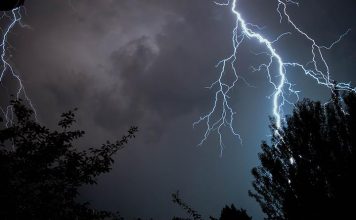 |
|
| Issue #132 • November/December, 2011 |
I like “doomsday” scenarios even ridiculous ones, such as the supposed Mayan calendar prophecy for 2012 or what had been Y2K doom-and-gloom leading up to the year 2000. Of course, there are some genuine doomsday threats to worry about, such as the possibility of another flu pandemic like the one of 1918-1919 or other pandemics health officials worry could be caused by drug resistant “superbugs” that could kill tens of millions, if not hundreds of millions, worldwide.
There are also unlikely but plausible catastrophes I like to mull over, such as the eruption of one of the world’s super volcanoes, the impacting of a large asteroid, or the onset of another glacial age, all of which are going to happen eventually and, if one of those happened now it could wipe out as much as 90 percent of humanity, and we’re powerless to stop them.
But what if there was a well-documented, but preventable threat, that could bring this country to its knees and kill as many as a quarter of a billion Americans, yet we were doing nothing to prevent it. In fact there are fixes we could put in place now to lessen the consequences but the media and our nation’s leaders not only ignore it, Congress has even cut money from the budget that could provide the means to deal with it.
The threat is called electromagnetic pulse (EMP) and it could come about as the result of detonating one well-placed nuclear device high over the United States. In fact, it could happen even without a nuclear attack as a result of a naturally-occurring solar flare from our own sun.
What is EMP?
According to a government website, an EMP is: “The electromagnetic radiation from a nuclear explosion caused by Compton-recoil electrons and photoelectrons from photons scattered in the materials of the nuclear device or in a surrounding medium. The resulting electric and magnetic fields may couple with electrical/electronic systems to produce damaging current and voltage surges.”
All you really need to pay attention to is the last sentence. EMP is an electromagnetic surge that would follow the high-altitude detonation of a nuclear bomb. It could turn the United States into a Third World country.
Without going deep into physics, an EMP caused by a nuclear bomb has three components. The first, designated E1, is the result of electrons being stripped from atoms in the upper atmosphere in the aftermath of a high-altitude detonation. As they travel downward through the earth’s magnetic field at near-relativistic speeds, they produce a massive, though momentary, electromagnet pulse. You won’t feel it, but the electronic equipment all around you will. In the old days of vacuum tubes and relay switches, most equipment would likely have escaped damage from the E1 component of the pulse. But today’s microchips and delicate electronic devices, though incredibly convenient and efficient, will be fried by the pulse. Things like modern automobiles and trucks, computers, radios, televisions, cell phones, pacemakers, and anything else dependent on computer chips, whether plugged into the power grid or not, will short out and simply stop working. Kaput!
This also includes aircraft in the sky. Unless their avionics are “hardened” (and commercial aircraft and most military aircraft are not hardened against EMP), they will simply cease operation and the thousands that are in the air at any moment are going to simply fly into the ground with everyone onboard. Almost all microelectronic components damaged by the E1 component of an EMP will be unrepairable.
The E2 component resembles the surges caused by lightning and are less likely to be damaging to most equipment. But if protective equipment such as surge protectors are damaged by the E1 pulse, it may now allow the E2 pulse to cause further damage.
The E3 component may be the worst. It is caused when a nuclear explosion distorts the earth’s magnetic field. As the field distorts, then tries to regain its original shape, it induces currents into long metal conductors like the power lines and such that crisscross the country. The longer the conductors, the more current will be produced. It is this component of EMP that will overload the nation’s power grid and fry everything connected to it, from your laptop, which is plugged into the wall recharging, to the transformers at the power stations.
The 370 or so largest transformers connected to nuclear, hydro, and fossil fuel-burning power plants around the country are what make the electricity these plants generate usable, but they will be destroyed by the pulse. Without these transformers, the country will go dark. And they cannot be easily replaced. The size of a building, they are no longer produced in the United States and current procurement time is three years.
What will happen?
Without electric power, radio and TV stations and phone services won’t work, so there’ll be almost no communication. Water systems will cease to function, gas stations won’t be able to pump fuel, banking transactions (including ATMs) will fail, and the network for distributing food will collapse. Perishable foods and medications that require refrigeration or freezing will spoil in a day. Emergency services will be unavailable, including those necessary to fight the tens of thousands of fires that will start from short circuits on the grid.
The inability to produce or distribute proper medications would doom many needing cancer treatments or suffering from heart disease, Type I diabetes, and other ailments.
Most farmers won’t be able to plant, fertilize, irrigate, or harvest, but even if they could, they won’t be able to get their products to market because there will no longer be transportation. What is harvested won’t be preserved since there will be no power to run refrigeration and none to run the factories that ordinarily can our food.
Supermarkets typically have just a few days’ supply of food and are being resupplied continuously every 1-3 days. Once the power goes out, the supermarkets will quickly be emptied and it could be months before they’re resupplied.
Imagine the great metropolitan areas of this country: the corridor from Boston to Washington, DC, which includes the great cities of New York and Philadelphia among them, and has a population of about 50 million people, the Chicago area with its millions, the Los Angeles to San Diego corridor, Seattle, Portland, etc., and suddenly there’s no food coming in, the water is turned off, and sewage facilities no longer carry away and treat our daily waste.
In no time at all cities will become quagmires of hungry, thirsty people living amid filth, squalor, and disease.
From an enemy’s point of view, a single large device exploded 250 to 300 miles above Iowa would disrupt the entire United States. But getting a missile that far inland could be a problem for them. On the other hand, because the radius of destruction of one high-altitude explosion is very large (as much as 1400 miles), three missiles, launched almost straight up, from freighters off the Pacific, Atlantic, and Gulf coasts, should just about cover the lower 48 states with EMP surges that would all but incapacitate our nation.
Recovery time, if it happened, would take years but more likely a decade or more. In the meantime, deaths in this country would be at least in the low millions.
All of this would seem to be the fodder for fiction and, in fact, a scenario involving an EMP attack is played out in a book by William Forstchen titled One Second After. Though he’s populated the book with rather two-dimensional characters, the events described in the book are credible and thought-provoking and make it worth a read.
The problem with an EMP event is not news. We’ve known about nuclear weapon-induced EMP since 1945. Enrico Fermi anticipated it prior to the detonation of the first atomic bomb, called Gadget, at the Trinity test site in New Mexico. The media and the American people briefly became aware of it after a high-altitude detonation of a hydrogen bomb during the Starfish Prime Test of 1952 when effects of it were felt in Hawaii (900 miles away from the test), where the resulting voltage surges blew out 300 street lights and damaged a microwave link. This was with a weapon that wasn’t even designed to maximize EMP and it was detonated back in the day of vacuum tubes when electronic equipment was more robust than today’s highly efficient but sensitive computer chips which can be fried by even modest current surges.
Solar flares
Even if someone were able to convince me no one would ever launch a nuclear weapon over the United States, I would not rest easy. Nuclear weapons are not the only things that cause an E3 pulse. A giant solar flare caused such a pulse on September 1, 1859. Back then, there was no electronic infrastructure, but telegraph lines acted like antennas and transmitted the energy along their wires, causing shocks to many telegraph operators and, in some cases, causing fires. A large solar flare of this sort is now called a Carrington Event, named after the British astronomer, Richard Carrington, who first described it.
Solar astronomers and many engineers feel that with the United States (and most of the rest of the industrial world) now crisscrossed with power and communication lines, a solar flare with the magnitude of the one that occurred in 1859 would blow out power station transformers and plunge this country and much of the rest of the world into the dark for years. (Imagine trying to build transformers if there’s no electricity at all!) It could also cause fires across the continents as circuits overload, overheat, and arc.
The 1859 event is not the only time solar flares have wreaked havoc. It’s happened many times since, only on smaller scales because the flares were much smaller. The 1859 solar flare happened at the dawn of the electric age. Had it happened a few decades later when the world was more electrified, we’d probably now take the threat seriously and we’d have been “hardening” the grid to EMP all along. But it didn’t, and we haven’t.
Solar astronomers are positive it’s only a matter of time before there will be another Carrington Event. They just don’t know when. However, next year is one of the prime times it may happen. NASA says the solar cycle we’re entering now is about the same size as the one that produced the original Carrington Event.
With a major Carrington Event, all the things that could follow a nuclear weapon-induced E3 strike may happen, except it won’t be just a local event but one that affects the entire world.
The solution
The lowest estimate I’ve seen for the projected cost of a recovery for just the solar disruptions is $1 trillion, but most estimates run into the many trillions of dollars. However, the FBI projects the cost of hardening transformers that service major metropolitan centers at about $200 million. That’s 1/5000th of the smallest estimate of the cost of damage. In fact, it’s less than 1/2000th of the job package President Obama recently proposed. And hardening the grid wouldn’t just make the country more secure, it would provide meaningful jobs, unlike the kinds government spending usually create.
There are voices trying to call attention to the problem. The Heritage Foundation has been calling for a national EMP recognition day to raise awareness of the threat.
An EMP attack will be the most catastrophic event to happen to our nation in its history more devastating than 9/11, more devastating than Pearl Harbor, in fact, more devastating than all of the wars this country has ever fought.
It’s about time for the mass media to talk about it, and for Congress and the President to address it. This is a real-world problem with a relatively inexpensive fix.













